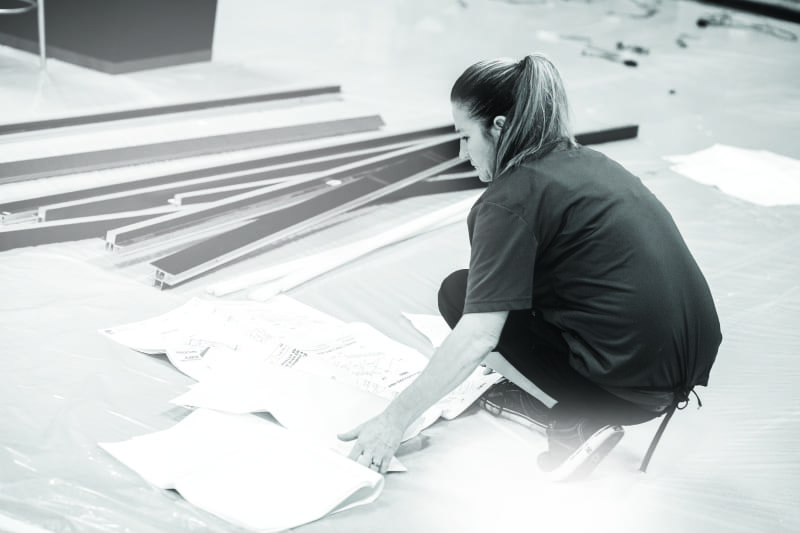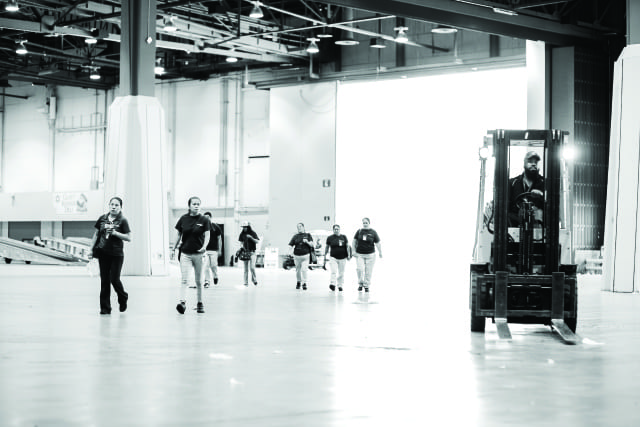Traditionally male dominated industry
Building, construction, carpentry and technology industries are traditionally male dominated, and the tradeshow installation industry is no exception. Because of its roots in those industries, exhibit house workers, managers and owners from the 1970s through most of the 1990s were predominantly men.
However, women are taking on leadership positions in male-dominated roles across all industries. Most recently, Jen Welter was hired as the first female NFL coach for the Arizona Cardinals. Tech companies like Google are rapidly training and hiring women who code, making women with tech skills in high demand and offering them lucrative salaries. Most interestingly, the debate around women in these roles has shifted from an issue of fairness and equality to a question of superior performance.
The best teams have both men and women. A 2011 study showed that teams with a 50-50 balance of men and women performed the best in business because they were doing more “mutual monitoring,” or checking to make sure everyone’s doing their job. (http://www.fastcompany.com/3015112/leadership-now/why-productive-teams-have-3-kinds-of-diversity)

Women in the top leadership position also help a company’s performance and the bottom line. A Credit Suisse analysis of almost 2,400 international companies found that companies with at least one woman on their board tend to be the strongest performers. The study also showed that those companies’ stocks outperform companies with no women on the board by 26 percent over the course of six years.
The number of women on both the exhibitor and supplier sides has increased dramatically in the last 20 years. In the tradeshow industry, there is a notable trend for women who were executive assistants or in other administrative roles and who showed a proficiency for managing details, processes and people, to assume complex tradeshow program management responsibilities. Although women crowd the aisles as attendees at EXHIBITORLive! there are still not as many women in the labor segment. We were able to talk with two women who are leaders in the I&D industry.
Starting from the bottom-up
It was 1985, and Laura Fee had recently become the first person in her family to graduate from college. She was unemployed when her uncle, who owned a window company, asked the 25-year-old Fee to help him set-up and work the booth at a housing tradeshow at the Cleveland Convention Center. In her marketing textbook from college, the only mention of tradeshows was “tradeshows, another form of marketing.” Not knowing anything about tradeshows, Fee agreed and helped set-up the booth by dressing the windows with flowers and working as a model in the exhibit.
During the show, Fee remembers walking from behind a crate and running into a friend she hadn’t seen since high school. He worked for Andrews Bartlett, a general contracting company (acquired by Freeman in 1993), and Fee asked him for a job. Soon after, she was hired to work with another man in starting the sales division of its labor arm called Exhibition Contractors Company.

She was on the road two weeks of every month to work the service desk at tradeshows where Fee said, “It was trial by fire.” Early in her new job, she remembers working the desk at an auto show in Cleveland when the city manager said, “I’ll be right back,” and left the neophyte Fee in charge of 120 laborers working the show floor.
Time passed, and as workers were heading to lunch, the crews needed adjusting. Customers approached the desk asking for things to be built or requesting special tools that Fee had never heard of. Keeping calm, Fees took notes, smiled and said, “No problem.” Meanwhile, the city manager was nowhere to be found and the customers needed help. Taking action, Fee sought her brother, who was a worker on the show floor, to help her find tools and direct the customers.
She took control and ran the labor crews on the show floor through the duration of the show, and by the end, Fee had learned how to run the labor crews, identify the tools and help customers get what they needed. She showed that she was capable of doing the city manager’s job, because the city manager never returned.
“It was definitely a man’s world,” remembered Fee. “I’ve been very outspoken and independent, but never considered myself tough. I had to prove that I could hold my own.”
She remembered another time when a customer’s sign was going to be removed because it was hitting lights when hung from the low ceiling and could be a fire hazard. A group of men were assessing the situation when Fee spoke up and told them that the sign would clear the lights if it was spun into a diamond instead of a square. The men completely ignored the 26-year-old young woman.
Anything can go wrong at a live event, but the most successful people are problem solvers who don’t let their egos get in the way. Fee told another male worker on the show floor her recommendation, and he walked over to the group of men and was able to carry out the solution.
“Things can go wrong that are out of our control. [You’ve got to] find out how to make it work. You can’t worry about egos,” said Fee. “Our customers need to be able to market their product efficiently and it’s [got to] look good too. You have to remain calm and check your ego at the door.”
Fee became the first account executive at Eagle Management Group (EMG) in 1990 and worked with the owners to grow the firm from a small Northeast Coast company to a national labor supplier. At this time, the industry was undergoing huge changes in exhibit design, budgetary restrictions and regulatory requirements. During this time of change, a woman was a breath of fresh air.
“Everyone was used to men knocking on their doors. When I knocked, I never knew if they were going to take me seriously. But once I had the opportunity to present, it was easier to close the sale,” said Fee.
Within three years of Fee joining the company, EMG opened 10 new locations from east to west coast.
“Laura has been a driving force in the trade show industry for over 25 years,” said Steve Matranga, owner and founder of EMG. “She joined our company in its infancy and her passion, charisma, creativity and high level of integrity helped to put us on the map.” Fee now serves as vice president of sales and marketing at Eagle Management Group, where she still carries her strong but humble work ethic.
“At EMG, we want to take care of the customers and the employees,” she said. “Yes, we’re a labor company, but we’re a solutions provider to make everything happen on the show floor.”
Fee recalled her first Exhibit Designers + Producers Association (EDPA) meeting in November 1994 when the majority of the women in attendance were wives, and she was one of approximately three women in the room who worked in industry.
“Today you go and it’s loaded with women,” she said. However, as a problem-solver simply seeking a solution, Fee concluded that “it doesn’t make a difference whether you’re a man or woman, it’s whether you do your job effectively.”
Moving into the industry laterally
Another woman who has made a huge impact on the labor supply industry is Amanda Helgemoe, CEO at Nuvista Event Management Services. Unlike Fee, Helgemoe moved into the industry laterally rather than working her way up.
She was working in the food industry as director of marketing when she was looking for a change. A customer’s husband introduced her to Jack McEntee, founder and owner of Nth Degree, who was looking for a new director of sales and marketing. Helgemoe saw the opportunity and made the switch. She learned the business while working at Nth Degree and Eagle Mangement Group before she realized that she could do it on her own with a different business model. She was asking questions that no one was able to answer, such as why there were inefficiencies, and she was able to see new opportunities.
She went to as many association meetings as possible, met as many people as possible and saw an opportunity to combine labor services with audiovisual services, leading to the founding of Nuvista with a partner in January 2000. In 2001, Helgemoe became full owner and quickly took the company national while doubling in sales for several years in a row. When electronics became significantly cheaper and customers starting buying their A/V equipment, the company adapted and shifted its focus to labor services.

As a woman owning and leading a national labor company, Helgemoe said the most common misconception is that her kind nature means that she’s not competitive.
“I’m a very nice person, and that’s associated with not making good business decisions or running a tight ship,” said Helgemoe. “Most people ask, ‘Is your husband in the business with you?’” She grew up in a family of entrepreneurs and they encouraged her to follow her dreams. She knew she would own her own business one day and it would probably be in construction.
Helgemoe graduated with an accounting and marketing degree from Michigan State University, and then worked at corporations including Fortune 100 company, Armstrong World Industries, where she learned the importance of culture in organizations.
“My philosophy is to manage within and create a culture that shows mutual respect and to follow your values,” said Helgemoe. “That will flow into the outside world, which in turn pays dividends to our clients.”
Women of the future
While the acceptance and respect for women has progressed significantly, the labor industry is still predominantly male. This may be due to external forces, for there are few barriers to women joining the industry, but women are not encouraged to do this type of work. The work itself is practical, and the American culture has conditioned women to prefer the luxuries of a purse as opposed to a tool belt, and manicured nails to chipped and grimy.
Compared to men, women tend to face a huge learning curve in identifying the tools, let alone how to use them. Construction toys traditionally targeted boys and came in primary or military colors, while young girls were given dollhouses as a finished product, not as a kit for them to construct. Young girls were not typically raised with parents encouraging them to enter construction, although this is changing.
Understanding that women in business improves performance, the most progressive businesses are seeking to hire and train women, creating a huge demand and opportunity for women with the skills needed in predominantly male industries, particularly math, science and technology.
In November 2013, crowd-sourced GoldieBlox brought national attention to the issue when its YouTube advertisement went viral. The GoldieBlox kits are designed for girls, who prefer pastel colors of robin’s egg blue, lavender and daffodil, and think in terms of relationships and storytelling.
Elizabeth Weiss wrote in the New York Times, “Toys that promote skills in science, technology, math and engineering (a category known as STEM), particularly for girls, are becoming increasingly popular.
“Stephanie Oppenheim, the co-founder of ToyPortfolio.com, an independent consumer organization that reviews children’s media and toys, described this as a significant development. ‘I’ve been covering the toy industry since 1989, and it’s one of the most welcome trends we’ve seen in a long time,’ she told me. ‘There’s such an uptick in toys that really engage kids in thinking about all the STEM topics’.”
http://www.newyorker.com/business/currency/can-toys-create-future-engineers
The theory is that kids who play with STEM-oriented toys are given the opportunity to think critically and problem-solve, developing two important skills required by the STEM industries as well as the tradeshow industry. It’s too early to predict whether this will increase the number of women who work in I&D, but the trend shows that women are valuable partners in business, and young generations of women are now being encouraged to reach their full potential. In 2013, Warren Buffett wrote in his Fortune column, “We’ve seen what can be accomplished when we use 50 percent of our human capacity. If you visualize what 100 percent can do, you’ll join me as an unbridled optimist about America’s future.” (http://www.businessinsider.com/warren-buffetts-advice-to-women-2013-5#ixzz3hgZrnNJp)




























